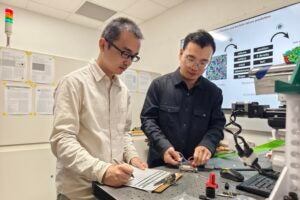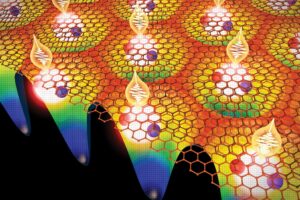
All of the cranes, trucks and construction crews that occupied sections of campus recently have given way to three new, state-of-the-art buildings. And while they are home to diverse disciplines communications, liberal arts and computer science the new additions to campus all share a focus on sustainability.
These buildings the Belo Center for New Media, the Liberal Arts building and the Bill and Melinda Gates Computer Science Complex, which includes Dell Computer Science Hall have opened in the past six months, adding nearly 500,000 square feet of classrooms, study areas, laboratories, auditoriums, meeting rooms and offices to the campus.
And they are visible examples of the university’s commitment to sustainability. The commitment ranges from everyday concerns like recycling and reducing paper use to how its largest structures are built and operated.
“Sustainability is never just a technology or a checklist,” says Rustam Mehta, one of two architects from Pelli Clarke Pelli Architects who designed the computer science building. “Every sustainable item should be there because it enhances the appearance of the building, the life of the occupants and the health of the occupants.”

Sustainable factors start from the ground up: From materials used in the interiors, to modern HVAC systems and even window placements, the buildings feature myriad examples of ways that design, materials and technology reduce the amount of energy and water the buildings use. For example, energy-efficient windows help keep heat or cold from coming in the building, and shadings such as long overhangs also protect the interiors at times of high heat.
The result is lower long-term costs for operating the buildings, as well as a reduced impact on the environment.
As the campus’s building inventory turns over, the university requires that new buildings and renovations meet at least the silver standard set by the Leadership in Energy and Environmental Design (LEED), which is defined by the U.S. Green Building Council.

LEED ratings range from basic to silver to gold to platinum. The rating is determined by points on a checklist, which covers energy efficiency, water efficiency, materials and resources and indoor environmental quality.
The three newest buildings meet the silver standard. By the time final reckoning is done, the Belo Center and Liberal Arts building might be gold. Five other buildings constructed during the past six years have achieved LEED gold.

Saving resources translates into saving money, but it will take time to determine what kind of savings, says Steve Kraal, senior associate vice president in the Office of Campus Planning and Facilities Management. Comparisons of energy use, where the first savings would be seen, are based on a modeling process that compares the LEED building to a hypothetical building, Kraal explains.
“We are still learning how that energy modeling process compares to the actual operation of a building,” he says. “Because there are not two side-by-side buildings, one LEED and the other ‘not LEED,’ an effective comparison of building performance is difficult.”
But with the three newest buildings, “we are much better informed and should be able to make some quantitative assessments of building performance,” he says.
See slideshows with more photos of the Liberal Arts building, the Belo Center and the Gates-Dell Complex.
Related links:
Sustainability Initiatives at the University of Texas at Austin Division of Housing and Food Service



